Siqi Yang
Metis-HOME: Hybrid Optimized Mixture-of-Experts for Multimodal Reasoning
Oct 23, 2025Abstract:Inspired by recent advancements in LLM reasoning, the field of multimodal reasoning has seen remarkable progress, achieving significant performance gains on intricate tasks such as mathematical problem-solving. Despite this progress, current multimodal large reasoning models exhibit two key limitations. They tend to employ computationally expensive reasoning even for simple queries, leading to inefficiency. Furthermore, this focus on specialized reasoning often impairs their broader, more general understanding capabilities. In this paper, we propose Metis-HOME: a Hybrid Optimized Mixture-of-Experts framework designed to address this trade-off. Metis-HOME enables a ''Hybrid Thinking'' paradigm by structuring the original dense model into two distinct expert branches: a thinking branch tailored for complex, multi-step reasoning, and a non-thinking branch optimized for rapid, direct inference on tasks like general VQA and OCR. A lightweight, trainable router dynamically allocates queries to the most suitable expert. We instantiate Metis-HOME by adapting the Qwen2.5-VL-7B into an MoE architecture. Comprehensive evaluations reveal that our approach not only substantially enhances complex reasoning abilities but also improves the model's general capabilities, reversing the degradation trend observed in other reasoning-specialized models. Our work establishes a new paradigm for building powerful and versatile MLLMs, effectively resolving the prevalent reasoning-vs-generalization dilemma.
DocTron-Formula: Generalized Formula Recognition in Complex and Structured Scenarios
Aug 01, 2025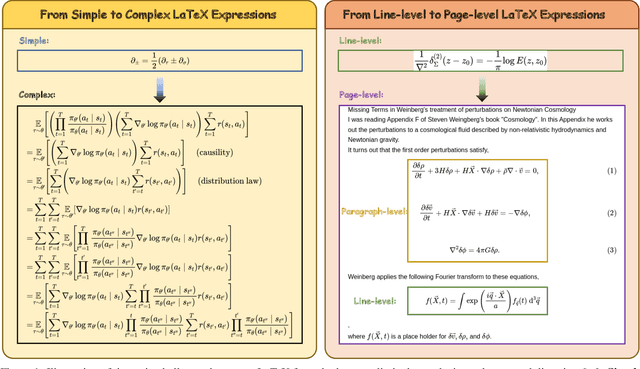


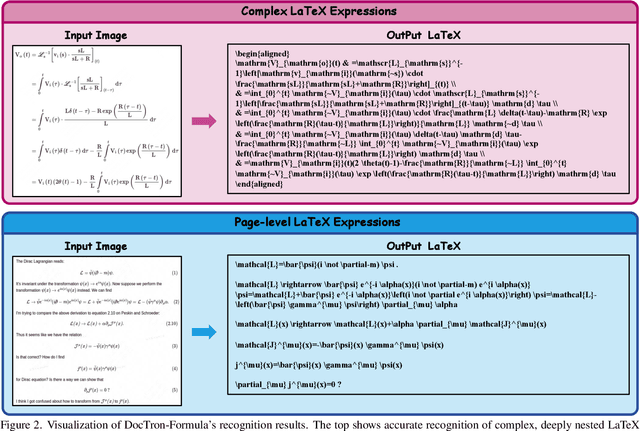
Abstract:Optical Character Recognition (OCR) for mathematical formula is essential for the intelligent analysis of scientific literature. However, both task-specific and general vision-language models often struggle to handle the structural diversity, complexity, and real-world variability inherent in mathematical content. In this work, we present DocTron-Formula, a unified framework built upon general vision-language models, thereby eliminating the need for specialized architectures. Furthermore, we introduce CSFormula, a large-scale and challenging dataset that encompasses multidisciplinary and structurally complex formulas at the line, paragraph, and page levels. Through straightforward supervised fine-tuning, our approach achieves state-of-the-art performance across a variety of styles, scientific domains, and complex layouts. Experimental results demonstrate that our method not only surpasses specialized models in terms of accuracy and robustness, but also establishes a new paradigm for the automated understanding of complex scientific documents.
PanoWan: Lifting Diffusion Video Generation Models to 360° with Latitude/Longitude-aware Mechanisms
May 28, 2025Abstract:Panoramic video generation enables immersive 360{\deg} content creation, valuable in applications that demand scene-consistent world exploration. However, existing panoramic video generation models struggle to leverage pre-trained generative priors from conventional text-to-video models for high-quality and diverse panoramic videos generation, due to limited dataset scale and the gap in spatial feature representations. In this paper, we introduce PanoWan to effectively lift pre-trained text-to-video models to the panoramic domain, equipped with minimal modules. PanoWan employs latitude-aware sampling to avoid latitudinal distortion, while its rotated semantic denoising and padded pixel-wise decoding ensure seamless transitions at longitude boundaries. To provide sufficient panoramic videos for learning these lifted representations, we contribute PanoVid, a high-quality panoramic video dataset with captions and diverse scenarios. Consequently, PanoWan achieves state-of-the-art performance in panoramic video generation and demonstrates robustness for zero-shot downstream tasks.
UniViTAR: Unified Vision Transformer with Native Resolution
Apr 02, 2025Abstract:Conventional Vision Transformer simplifies visual modeling by standardizing input resolutions, often disregarding the variability of natural visual data and compromising spatial-contextual fidelity. While preliminary explorations have superficially investigated native resolution modeling, existing approaches still lack systematic analysis from a visual representation perspective. To bridge this gap, we introduce UniViTAR, a family of homogeneous vision foundation models tailored for unified visual modality and native resolution scenario in the era of multimodal. Our framework first conducts architectural upgrades to the vanilla paradigm by integrating multiple advanced components. Building upon these improvements, a progressive training paradigm is introduced, which strategically combines two core mechanisms: (1) resolution curriculum learning, transitioning from fixed-resolution pretraining to native resolution tuning, thereby leveraging ViT's inherent adaptability to variable-length sequences, and (2) visual modality adaptation via inter-batch image-video switching, which balances computational efficiency with enhanced temporal reasoning. In parallel, a hybrid training framework further synergizes sigmoid-based contrastive loss with feature distillation from a frozen teacher model, thereby accelerating early-stage convergence. Finally, trained exclusively on public datasets, externsive experiments across multiple model scales from 0.3B to 1B demonstrate its effectiveness.
Unsupervised Cross-Domain Regression for Fine-grained 3D Game Character Reconstruction
Dec 11, 2024Abstract:With the rise of the ``metaverse'' and the rapid development of games, it has become more and more critical to reconstruct characters in the virtual world faithfully. The immersive experience is one of the most central themes of the ``metaverse'', while the reducibility of the avatar is the crucial point. Meanwhile, the game is the carrier of the metaverse, in which players can freely edit the facial appearance of the game character. In this paper, we propose a simple but powerful cross-domain framework that can reconstruct fine-grained 3D game characters from single-view images in an end-to-end manner. Different from the previous methods, which do not resolve the cross-domain gap, we propose an effective regressor that can greatly reduce the discrepancy between the real-world domain and the game domain. To figure out the drawbacks of no ground truth, our unsupervised framework has accomplished the knowledge transfer of the target domain. Additionally, an innovative contrastive loss is proposed to solve the instance-wise disparity, which keeps the person-specific details of the reconstructed character. In contrast, an auxiliary 3D identity-aware extractor is activated to make the results of our model more impeccable. Then a large set of physically meaningful facial parameters is generated robustly and exquisitely. Experiments demonstrate that our method yields state-of-the-art performance in 3D game character reconstruction.
Artificial Leviathan: Exploring Social Evolution of LLM Agents Through the Lens of Hobbesian Social Contract Theory
Jun 20, 2024



Abstract:The emergence of Large Language Models (LLMs) and advancements in Artificial Intelligence (AI) offer an opportunity for computational social science research at scale. Building upon prior explorations of LLM agent design, our work introduces a simulated agent society where complex social relationships dynamically form and evolve over time. Agents are imbued with psychological drives and placed in a sandbox survival environment. We conduct an evaluation of the agent society through the lens of Thomas Hobbes's seminal Social Contract Theory (SCT). We analyze whether, as the theory postulates, agents seek to escape a brutish "state of nature" by surrendering rights to an absolute sovereign in exchange for order and security. Our experiments unveil an alignment: Initially, agents engage in unrestrained conflict, mirroring Hobbes's depiction of the state of nature. However, as the simulation progresses, social contracts emerge, leading to the authorization of an absolute sovereign and the establishment of a peaceful commonwealth founded on mutual cooperation. This congruence between our LLM agent society's evolutionary trajectory and Hobbes's theoretical account indicates LLMs' capability to model intricate social dynamics and potentially replicate forces that shape human societies. By enabling such insights into group behavior and emergent societal phenomena, LLM-driven multi-agent simulations, while unable to simulate all the nuances of human behavior, may hold potential for advancing our understanding of social structures, group dynamics, and complex human systems.
RiEMann: Near Real-Time SE-Equivariant Robot Manipulation without Point Cloud Segmentation
Mar 28, 2024



Abstract:We present RiEMann, an end-to-end near Real-time SE(3)-Equivariant Robot Manipulation imitation learning framework from scene point cloud input. Compared to previous methods that rely on descriptor field matching, RiEMann directly predicts the target poses of objects for manipulation without any object segmentation. RiEMann learns a manipulation task from scratch with 5 to 10 demonstrations, generalizes to unseen SE(3) transformations and instances of target objects, resists visual interference of distracting objects, and follows the near real-time pose change of the target object. The scalable action space of RiEMann facilitates the addition of custom equivariant actions such as the direction of turning the faucet, which makes articulated object manipulation possible for RiEMann. In simulation and real-world 6-DOF robot manipulation experiments, we test RiEMann on 5 categories of manipulation tasks with a total of 25 variants and show that RiEMann outperforms baselines in both task success rates and SE(3) geodesic distance errors on predicted poses (reduced by 68.6%), and achieves a 5.4 frames per second (FPS) network inference speed. Code and video results are available at https://riemann-web.github.io/.
LongDanceDiff: Long-term Dance Generation with Conditional Diffusion Model
Aug 23, 2023



Abstract:Dancing with music is always an essential human art form to express emotion. Due to the high temporal-spacial complexity, long-term 3D realist dance generation synchronized with music is challenging. Existing methods suffer from the freezing problem when generating long-term dances due to error accumulation and training-inference discrepancy. To address this, we design a conditional diffusion model, LongDanceDiff, for this sequence-to-sequence long-term dance generation, addressing the challenges of temporal coherency and spatial constraint. LongDanceDiff contains a transformer-based diffusion model, where the input is a concatenation of music, past motions, and noised future motions. This partial noising strategy leverages the full-attention mechanism and learns the dependencies among music and past motions. To enhance the diversity of generated dance motions and mitigate the freezing problem, we introduce a mutual information minimization objective that regularizes the dependency between past and future motions. We also address common visual quality issues in dance generation, such as foot sliding and unsmooth motion, by incorporating spatial constraints through a Global-Trajectory Modulation (GTM) layer and motion perceptual losses, thereby improving the smoothness and naturalness of motion generation. Extensive experiments demonstrate a significant improvement in our approach over the existing state-of-the-art methods. We plan to release our codes and models soon.
Unsupervised Domain Adaptive Object Detection using Forward-Backward Cyclic Adaptation
Feb 03, 2020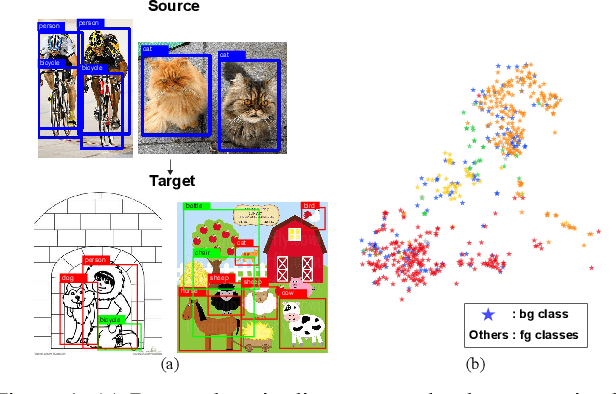


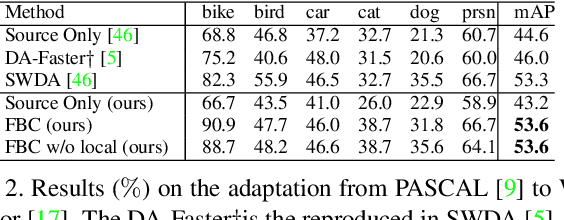
Abstract:We present a novel approach to perform the unsupervised domain adaptation for object detection through forward-backward cyclic (FBC) training. Recent adversarial training based domain adaptation methods have shown their effectiveness on minimizing domain discrepancy via marginal feature distributions alignment. However, aligning the marginal feature distributions does not guarantee the alignment of class conditional distributions. This limitation is more evident when adapting object detectors as the domain discrepancy is larger compared to the image classification task, e.g. various number of objects exist in one image and the majority of content in an image is the background. This motivates us to learn domain invariance for category level semantics via gradient alignment. Intuitively, if the gradients of two domains point in similar directions, then the learning of one domain can improve that of another domain. To achieve gradient alignment, we propose Forward-Backward Cyclic Adaptation, which iteratively computes adaptation from source to target via backward hopping and from target to source via forward passing. In addition, we align low-level features for adapting holistic color/texture via adversarial training. However, the detector performs well on both domains is not ideal for target domain. As such, in each cycle, domain diversity is enforced by maximum entropy regularization on the source domain to penalize confident source-specific learning and minimum entropy regularization on target domain to intrigue target-specific learning. Theoretical analysis of the training process is provided, and extensive experiments on challenging cross-domain object detection datasets have shown the superiority of our approach over the state-of-the-art.
Using LIP to Gloss Over Faces in Single-Stage Face Detection Networks
Jul 05, 2018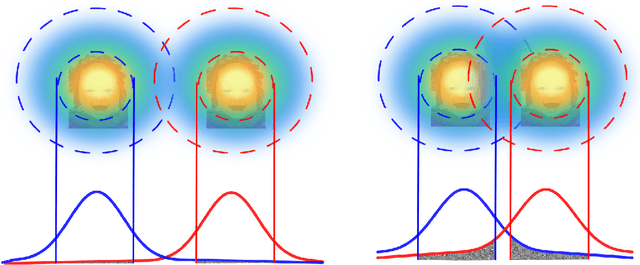
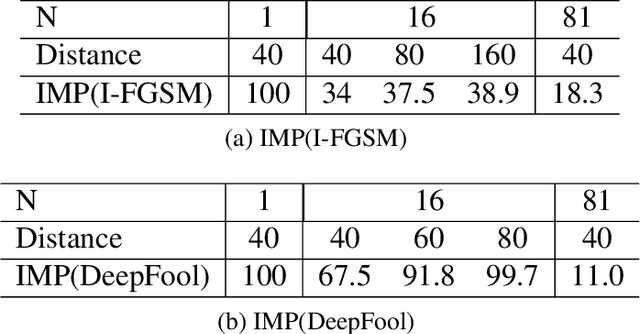
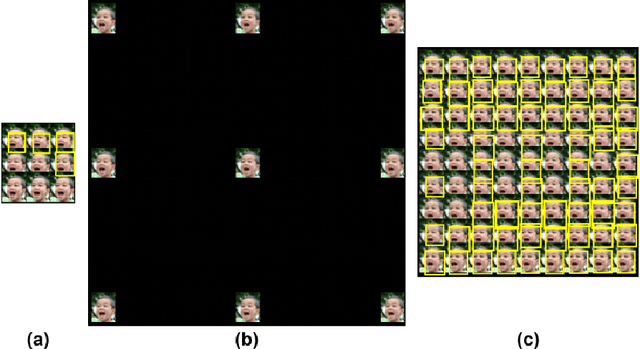

Abstract:This work shows that it is possible to fool/attack recent state-of-the-art face detectors which are based on the single-stage networks. Successfully attacking face detectors could be a serious malware vulnerability when deploying a smart surveillance system utilizing face detectors. We show that existing adversarial perturbation methods are not effective to perform such an attack, especially when there are multiple faces in the input image. This is because the adversarial perturbation specifically generated for one face may disrupt the adversarial perturbation for another face. In this paper, we call this problem the Instance Perturbation Interference (IPI) problem. This IPI problem is addressed by studying the relationship between the deep neural network receptive field and the adversarial perturbation. As such, we propose the Localized Instance Perturbation (LIP) that uses adversarial perturbation constrained to the Effective Receptive Field (ERF) of a target to perform the attack. Experiment results show the LIP method massively outperforms existing adversarial perturbation generation methods -- often by a factor of 2 to 10.
 Add to Chrome
Add to Chrome Add to Firefox
Add to Firefox Add to Edge
Add to Edge